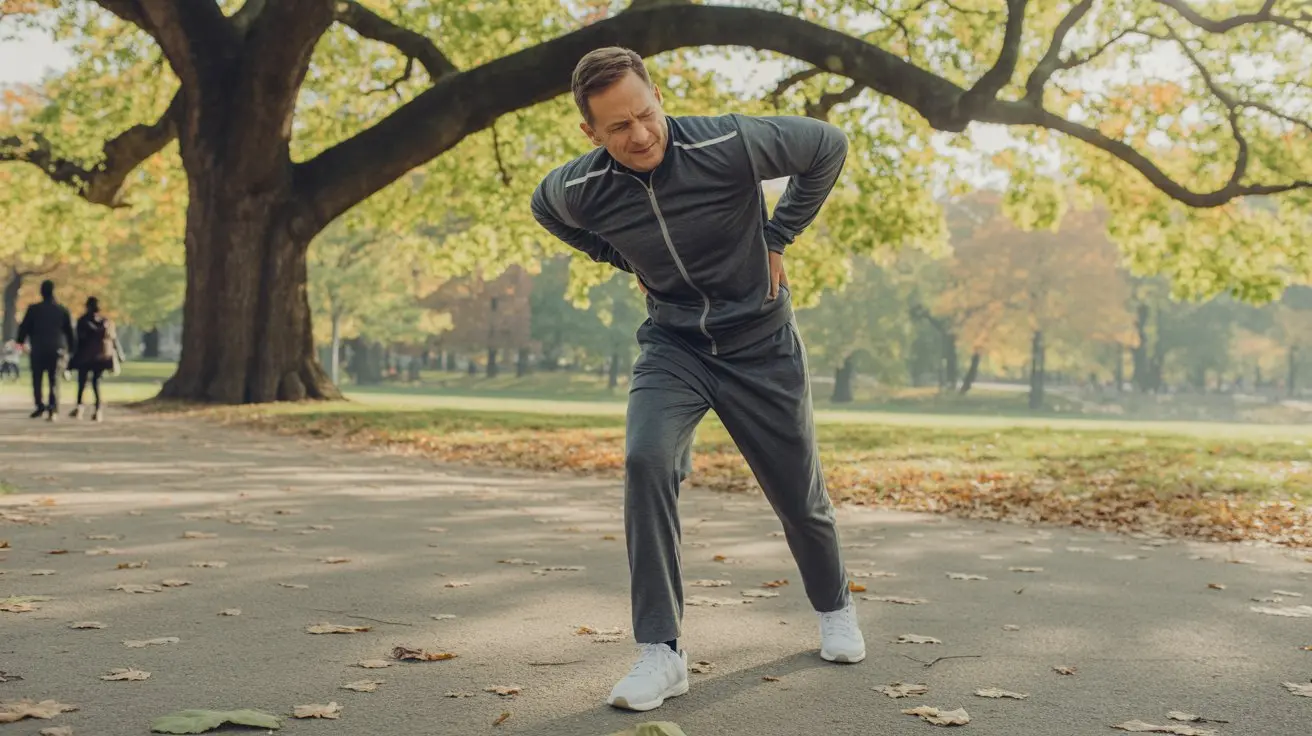You lace up, step out, and a few minutes later your lower back starts nagging again. If you’re dealing with low back pain from walking, you’re not alone—and there are clear, fixable reasons behind it. This guide explains what’s actually happening, how to match your pain pattern to likely causes, and a practical plan to stop flare-ups fast while keeping you confidently active.

Table of Contents
Key takeaways (read this first)
- “Mechanical” causes explain most low back pain from walking: how you move, the loads you carry, and the surfaces and speeds you choose.
- The fastest wins are simple: shorten your stride, raise cadence slightly, level your pelvis, and keep your arms swinging. These form tweaks often cut low back pain from walking by 30–50% within minutes.
- Capacity beats quick fixes. A small dose of hip and core strength work, 3–4 days per week, reduces low back pain from walking far more reliably than gadgets or restrictive belts.
- Red flags are rare, but important: sudden severe pain after trauma, progressive leg weakness, fever, true numbness in the groin/saddle region, new bowel or bladder trouble, or unexplained weight loss—get urgent care.
What causes low back pain from walking?
Walking is a rhythm of controlled falls. Each step sends force through your feet, legs, pelvis, and spine; when any link is overloaded, irritated tissues complain. The phrase low back pain from walking covers several patterns rather than a single diagnosis. Understanding your pattern helps you pick the right fix.
The usual suspects
- Overstride + low cadence. Long steps and a slow beat increase vertical bounce and braking forces. The spine must dampen more shock, making low back pain from walking more likely—especially on hard surfaces.
- Glute and hip weakness. When the lateral hip muscles tire, the pelvis wobbles side-to-side. That extra rotation forces the lumbar joints and discs to stabilize with every step, escalating low back pain from walking during longer walks.
- Spinal stenosis pattern. Narrowed spinal canals can pinch nerves when the back is arched. People feel low back pain from walking after 5–15 minutes that eases when they lean forward on a cart or sit—classic “shopping cart sign.”
- Facet joint irritation. Facets are small joints at the back of the spine. Walking fast with a deep arch can squeeze irritated facets, triggering low back pain from walking that improves when you slow down or flex a bit.
- Disc-related sensitivity. A sensitive disc dislikes prolonged extension or heavy axial load; some feel low back pain from walking with a backpack yet do better on slightly uphill routes that allow a gentler posture.
- SI joint overload. If one leg accepts more load or you carry a bag on one side, the sacroiliac joint can get cranky, creating low back pain from walking that radiates into the buttock.
- Foot/ankle mechanics. Stiff ankles, rigid shoes, or very uneven surfaces reduce shock absorption. Forces travel north, and low back pain from walking becomes the messenger.
- Deconditioning and fatigue. Detrained tissues complain under sustained load. The first few walks feel fine; then low back pain from walking arrives at the 20-minute mark as muscles tire.
Quick pattern matcher
Use these snapshots to narrow your driver and select a starting fix.
| If your pain behaves like this… | Likely driver | First tweak to try |
|---|---|---|
| Starts after 5–15 minutes, eases when you lean forward on a cart | Neurogenic claudication (stenosis-type) | Slight forward lean, shorter steps, consider slight uphill |
| Worse on fast, long-stride walks on flat concrete | Overstride + low cadence | Shorten stride 10%, raise cadence by ~5–10% |
| Flare with backpack or heavy purse | Extension/disc or SI joint load | Lighten/redistribute load; chest strap; alternate sides |
| Worse downhill; better slight uphill | Facet irritation or over-arch | Tuck ribs softly; keep pelvis level; reduce downhill time |
| One-sided buttock ache that pulses with steps | SI joint overload or hip weakness | Use two-strap backpack; add lateral hip strength |
| Only on very uneven trails or stiff shoes | Foot/ankle stiffness | Mobilize ankles; choose flexible shoes for longer walks |
Why “it only hurts after 10 minutes”
Tissues are happier below their fatigue threshold. Early in a walk, your system has reserve. As fatigue sets in, small wobbles and micro-extensions compound, and low back pain from walking appears. The fix is not to stop walking—it’s to improve efficiency and capacity so the same walk costs you less.
How to fix low back pain from walking (step-by-step plan)
Relief comes fastest when you pair form tweaks with small, consistent strength and mobility work. Here’s a blueprint you can start today.
Step 1: Reset the walk
- Cadence: Count steps for 30 seconds and double it. If you’re under ~110–115 steps/min, bump the beat by 5–10%. A quicker rhythm with shorter steps usually reduces low back pain from walking immediately.
- Stride: Think “soft feet, short steps.” Keep your foot landing close to your body to limit braking forces.
- Torso: Imagine a light magnet pulling your breastbone forward, not upward. This quiets excessive arching that feeds low back pain from walking.
- Arms: Let them swing. Stiff arms increase trunk rotation demands.
- Pelvis: Level the headlights (your ASIS) straight ahead. A level pelvis cuts rotational stress contributing to low back pain from walking.
Step 2: Choose smart routes and loads
- Prefer slight uphill over steep downhill if your pain fits a facet or extension-sensitive pattern.
- On sidewalks, favor softer paths or tracks when available; they’re kinder to irritated tissues that generate low back pain from walking.
- Keep hands free and use a two-strap backpack with a chest strap. Alternate which hand carries grocery bags to avoid one-sided low back pain from walking.
- Start with 10–15 minute loops and add 2–3 minutes every other session as tolerated.
Step 3: Micro-breaks that don’t derail momentum
Use a 90/30 rule: every 90 seconds of walking, spend 30 seconds focusing on one cue—short stride, level pelvis, soft ribs, easy arms. If symptoms climb above a 4/10, take a 60–90 second standing forward lean on a railing, then resume. These brief resets keep you moving while reducing low back pain from walking.
Step 4: Strength that pays rent
Two or three sets per exercise, 8–12 smooth reps, three or four days per week.
- Lateral hip strength (anti-wobble): Side-lying leg raises, banded side steps, and single-leg stands with a wall touch. Strong glutes prevent pelvic drop, a common driver of low back pain from walking.
- Hip extension strength: Bridges, hip thrusts, and step-ups. Restoring hip power reduces the need to over-arch the low back.
- Core anti-rotation: Tall-kneeling press-outs (Pallof), dead bug holds, and suitcase carries in short sets. These teach your trunk to resist unwanted twist that provokes low back pain from walking.
- End-range control: Cat-camel in small ranges and segmental bridge roll-downs to keep the spine comfortable moving through flexion/extension.
Step 5: Mobility where it matters
- Ankles: Wall ankle mobilizations (knee to wall) for 1–2 minutes per side. Better ankle motion lets you shorten stride without feeling “stuck,” easing low back pain from walking.
- Hips: 90/90 transitions and kneeling hip flexor stretches with a posterior pelvic tilt for 30–45 seconds, two rounds each side.
- Thoracic spine: Seated reach-throughs and open-book rotations; 5–8 smooth reps per side.
Step 6: Progression calendar (2–4 weeks)
- Week 1: Reset cues + 10–15 minute loops on level/soft surfaces. Strength/mobility on alternate days. Your test: does low back pain from walking reduce within the session when you apply cues?
- Week 2: Add 2–3 minutes per walk. Introduce gentle inclines if tolerated.
- Week 3: Two longer walks (20–30 minutes) with a light backpack using both straps.
- Week 4: Maintain cadence and stride. Begin one interval day: 3 x 4 minutes brisk + 2 minutes easy. Goal: complete sessions with minimal low back pain from walking.

Form tweaks that unload the spine
Small changes, big payoff.
Stride length and cadence
A 10% shorter stride with a 5–10% faster cadence typically reduces vertical oscillation and braking forces. Many people report their low back pain from walking drops a full point on a 0–10 scale after a few minutes with this change alone.
Arm swing and trunk rotation
Relaxed arm swing balances rotational forces. If your arms are frozen by phone use or tight shoulders, the lumbar spine must absorb more twist, inviting low back pain from walking. Stow the phone, free the arms, and let the ribcage rotate naturally.
Pelvic control
Imagine a full cup of tea on your sacrum—no spilling. Pelvic levelness keeps forces distributed evenly so low back pain from walking doesn’t accumulate on one side.
Shoes and surfaces
Use the most forgiving shoe that still feels stable. Very stiff soles on hard concrete add up; a moderate-cushion shoe or a softer track often reduces low back pain from walking. On trails, watch for long stretches of cambered or uneven ground that tilt the pelvis.
Loads and bags
Two-strap backpacks with chest/waist straps keep loads close to your center, reducing extension and side-bend forces that aggravate low back pain from walking. Avoid single-strap slings for long distances.
Strength & mobility menu (20–25 minutes, 3–4×/week)
Pick one from each category; rotate across the week.
A. Glutes & lateral hip
- Banded side steps (2 x 12–15 steps each way)
- Single-leg bridge (2 x 8–10/side)
- Step-ups (2 x 8/side)
B. Core (antirotation + endurance)
- Side plank (3 x 15–30 sec/side)
- Dead bug (3 x 6–8 slow reps)
- Tall-kneeling press-out (3 x 8 press/hold/return)
C. Hip flexor & thoracic mobility
- Half-kneeling hip flexor stretch with glute squeeze (2 x 30–45 sec/side)
- Open-book (2 x 6–8/side)
- Seated reach-through (2 x 6–8/side)
D. Ankle & foot
- Calf raises (2 x 12–15)
- Knee-to-wall ankle rocks (2 x 45–60 sec/side)
- Short-foot exercise (2 x 8–10 gentle holds)
Consistency here is what prevents low back pain from walking from coming back after you’ve calmed a flare.
Age-specific patterns you can recognize
Teens & 20s
Training spikes, long study hours, and weak glutes dominate. Low back pain from walking shows up on fast, flat campus routes and after long days in stiff shoes. Priorities: stride/cadence reset, lateral hip strength, and ankle mobility.
30s & 40s
Work sitting + childcare lifting means stiffer hips and deconditioned trunk endurance. Low back pain from walking arrives after 15–25 minutes and is worse with backpacks or pushing strollers uphill. Priorities: antirotation core work and load management.
50s & 60s
Facet irritation and early stenosis are more common. People report low back pain from walking on downhills and relief when leaning forward on railings. Priorities: gentle flexion-friendly routes, cadence up, hip extension strength.
70s & beyond
Bone health and balance matter more. Low back pain from walking may blend with hip or spinal arthritis. Priorities: shorter, frequent walks with a partner or pole for balance, plus twice-weekly strength for hips, calves, and grip.
Prevention stack (weekly template)
Think layers: form + capacity + recovery.
- Walk smart: keep cadence brisk, stride modest, arms free.
- Strength 3–4×/wk: glutes, core, calves.
- Mobility snacks: 5 minutes ankles/hips most days.
- Load wisely: split groceries into two bags; use chest strap.
- Surfaces: choose parks/track for long days to prevent low back pain from walking.
- Sleep & stress: run a consistent wind-down; poor recovery magnifies pain.
- Progress: add time or incline, not both in the same week.
Myth vs fact
| Myth | Fact |
|---|---|
| “If walking hurts, I should rest until it’s 100% better.” | Gentle, well-cued walking is therapeutic. Gradual exposure reduces sensitivity that fuels low back pain from walking. |
| “I need a brace to hold my back while I walk.” | Most people improve faster by training their own hip and core muscles; belts can be short-term aids, not solutions. |
| “Only expensive shoes fix this.” | Shoes matter, but cadence, stride, and strength shift loads more reliably than buying new gear. |
| “Downhill training builds toughness.” | Long downhills often aggravate facets; start with level or slight uphill if you get low back pain from walking. |
Red flags: when to seek medical care now
- Severe, unrelenting pain after a fall or accident
- New bowel or bladder control problems
- Numbness in the groin/saddle area
- Progressive leg weakness or foot drop
- Fever, chills, or unexplained weight loss
- History of cancer or osteoporosis with sudden back pain
If any of these are present with low back pain from walking, get urgent evaluation. For persistent or worsening symptoms despite 2–4 weeks of good self-care, consult a qualified clinician for an exam and tailored plan.
Frequently asked questions about low back pain from walking
Why do I feel low back pain from walking but not when I sit?
Sitting often flexes the spine slightly and unloads irritated facets or nerves. Walking with an extended posture, long stride, or low cadence can increase compressive and shear forces, bringing on low back pain from walking after a few minutes.
Is low back pain from walking a sign of spinal stenosis?
Not always. Spinal stenosis is one pattern where symptoms worsen with upright walking and ease with forward lean. Many others get low back pain from walking due to stride mechanics, hip weakness, or loads. Match your pattern to the fixes above before you assume stenosis.
How can I change my gait to reduce low back pain from walking right now?
Shorten your stride by ~10%, raise cadence 5–10%, relax the ribcage, and swing your arms freely. Most people feel less low back pain from walking within the same session using these cues.
What shoes help with low back pain from walking?
Choose a comfortable, moderately cushioned shoe with a stable heel. Extremely rigid soles on concrete can amplify impact. The right shoe supports the other changes that actually reduce low back pain from walking: cadence, stride, and strength.
Should I avoid hills if I have low back pain from walking?
Avoid long, steep downhills early on. Start with level or mild uphill routes that allow a touch of forward lean. Gradually reintroduce declines as your hips and core build capacity and you can maintain form without triggering low back pain from walking.
Will core exercises really help low back pain from walking?
Yes—especially anti-rotation work that keeps the pelvis level and limits unwanted trunk twist. Paired with hip strength, this reduces the micro-movements that cause low back pain from walking over distance.
How long until low back pain from walking improves?
Many notice relief in a single session with form resets. More durable change—where walks stay comfortable as you go longer or faster—usually builds over 2–4 weeks of steady strength and mobility plus smart progression of walking time.
Can a backpack cause low back pain from walking?
A heavy or poorly fitted pack can. Use two straps, a chest strap, and keep loads close to your torso. Alternate carrying hand-held loads. If the pack is essential, build hip and core strength so it doesn’t trigger low back pain from walking.
Do I need imaging for low back pain from walking?
Most don’t. Imaging is considered when there are red flags or when symptoms persist despite good rehab strategies. Imaging results rarely change the first-line plan to address low back pain from walking: adjust form, build capacity, and manage loads.
What’s the best warm-up to prevent low back pain from walking?
Spend 3–5 minutes on ankle rocks, open-books, and 1–2 short strides with quicker cadence. Then start your walk with short steps and easy arm swing. These primes cut early spikes of low back pain from walking and set you up for a better session.
Further reading (trusted resources)
- MedlinePlus: Low back pain overview
- Mayo Clinic: Spinal stenosis
- 7 Low Back Pain Exercises Physical Therapists Swear By
- Doctor Explains What Causes Lower Back Pain and How to Prevent and Reset It

Dr. Vivek Arora (BPT, MPT, FRCPT, MIAP) is a licensed physiotherapist with over 20 years of experience in spine and joint care. He specializes in evidence-based physiotherapy, patient education, and long-term recovery without surgery. Passionate about empowering patients through knowledge, Dr. Arora shares expert-backed health content for a global audience.
To know more about Dr. Vivek’s journey, click here.
